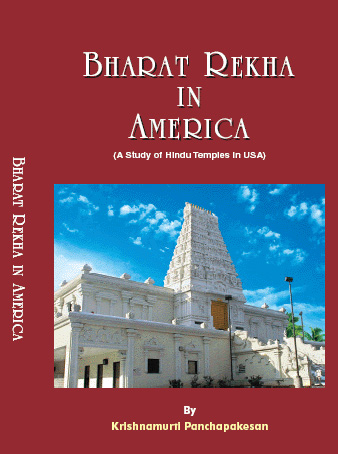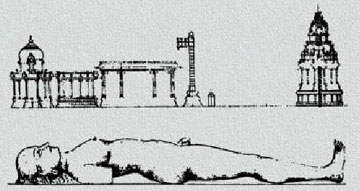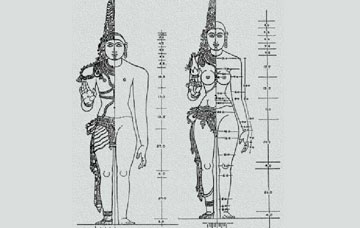Bharat Rekha in America
BY: SUN STAFF

Jul 31, WASHINGTON, DC (SUN) — New Vrindaban featured in new book on traditional Hindu temple architecture in the U.S.
Author K. Panchapakesanand and U.S. Congressman Joe Wilson of South Carolina, jointly released "Bharat Rekha in America," a guide to 53 Hindu Temples in 33 American states. In his welcoming address, Congressman Wilson lauded the efforts of Mr. Panchapakesanand for publishing such an outstanding book which will help the Hindu Community in America.
In his address, the author highlighted the two objectives of the book. First to be a directory of Hindu temples in the United States and secondly to help strengthen the socio-cultural bridge between the peoples of the USA and India. Mr. Panchapakesanand's next project is to publish a world directory of Hindu temples, which he says would be the first of it kind.
Hindu Temple Culture in America
The book's authors pose the question, "Did Hinduism arrive 40,000 years ago in the geographic region, which is currently USA? So says an interesting report. Mr.N. Ganesan, a known writer on the subject of History of Hinduism has referred to it in his article in a popular magazine of USA, backing it with data from Text Books of reputed Book Publishers.
Additionally Jagadguru Sankaracharya, Sri Chandrasekharendra Saraswathi Swamiji of Kanchipuram, India, who was popularly called as the “Walking God, for his Divine Powers, Spirituality, Universal Love, and Service to Humanity, had said in a speech in 1935 that “Kapilaranya” (meaning Kapila forest) mentioned in the Ancient scriptures of Hinduism was the same as today’s California State of USA."
Relating this to an event mentioned in Ramayana, "Aswametha Yaga" was a ritual generally performed by the Kings in olden times in which horses were worshipped. After the ritual, the horse used to be let free to roam and the places visited by the horse used to become the territories under the control of the King. If the movement of the horse was interrupted or obstructed by anyone, then it meant a war between the King and the person so that the victor would become the owner of the territories.
It is said in Ramayana that King Sagara did such an ”Aswametha yaga” and the horse disappeared because God Indra had taken it away. Not knowing who took the horse away, the King sent his sons to track down the horse. Having failed after repeated efforts to spot the horse, the princes dug deep into the ground and reached the other end of the Globe thinking that the horse could be found there. There, right at the bottom of the Globe, they saw the horse tied next to a sage Kapila in penance. When the princes disturbed the sage and asked him if he brought the horse, the sage is supposed to have got angry and burnt the princes to ashes with his powerful eye radiation. On knowing this, the King approached the sage for resurrecting the bodies back to life. The sage is supposed to have said that such a possibility could be achieved if the water from Ganges River (considered sacred) was brought and sprinkled on the dead. This was achieved after intense efforts.
According to Jagadguru Sankaracharya all this happened in “Kapilaranya” which is exactly opposite to India in the Globe and which is currently California. Geography, of course, confirms that India and California locations are diametrically opposite to each other on the Globe. Therefore if one were to notionally pierce a needle from India on the Globe, it would hit California directly at the bottom. This also corroborates the view that the princes who dug deep into the ground from India reached California at the bottom. Also the existence of “Ash Island” and “Horse Island” next to California today lends credence to this explanation suggesting that “Ash Island” was the place where the princes were burnt to ashes and the “Horse Island” was the location where the horse was tied. Hindus popularly believe that the epic Ramayana happened at least 100,000 years ago. So, could it be that Hinduism is 100,000 years old and spread to far off locations including the geographic area, which is USA today?

Going back to comparatively recent times, information is available that Hinduism arrived in USA over 100 years ago, with the travel of many Sages and Saints from South Asia to that country.
It is said that the first Hindu place of worship came up in California in the early 1900s. The spurt for construction of Temples increased substantially in the 1930s, picking up intense momentum in the 1950s and 1960s with the increase of Indian immigrants to the USA at that period. Presently the Temples in the USA are estimated to be in excess of 400. The Hindu population of the USA is reckoned close to two million.
Like in any evolution, Temple construction in the USA also underwent changes, modifications and development over a period of time. Today’s Hindu Temples of the USA have come a long way from those of the initial days when they offered restricted timings and services to the public due to various limitations including shortage of priests. Now most Temples are open seven days a week, with priest’s full time in attendance offering various types of worship. Better organized than before and offering almost all needed facilities. We need to pay a great tribute to the Hindus of the USA for their strong faith and progress in the establishment of more Temples, despite meeting the calls of continuously increasing adjustments.
The USA has Hindu Temples in almost all the States. The number of Temples ranges from one or two in a state to five or six in some others. There are many traditionally built Temples. The Sri Venkateshwara Temple in Pittsburgh is said to be one of the earliest traditionally built Temples in recent times. There are many other Temples built in similar South Indian Style. The Sri Siva Vishnu Temple in Lanham, Maryland, the Sri Meenakshi Temple in Peerland, Texas, the Hindu Temple of Atlanta, the Sri Venkateswara Temple of Greater Chicago and the Mahavallabha Ganapati Temple, Flushing, to name a few. There are also Temples of North Indian style. The rest of the Temples are housed in independent buildings. Some of these Temples are being converted to traditional. Appearance with the construction of towers or gopurams.
In the traditionally built Temples, the idol is made out of the prescribed granite stone. Over 25 Temples in America have been built by well-known Indian Sthapathis (Temple Architectural experts). In the case of other Temples, the idols are different, made out of varied materials. The Founder Members of a Temple generally take intense interest. The day-to-day administration is either looked after by the Founder Members themselves or by an appointed Administration Committee. Almost all Hindu Festivals and functions are celebrated with great fervour. The Temples offer seven day-a week worship and provide all facilities needed. The attendance of devotees is generally high over weekends. Most of the Temples have websites in which all details are mentioned. Generally, at least two priests are available in each Temple for carrying out the rituals. Devout fervour, sanctity, cleanliness and discipline are some of the outstanding features that one sees in these Temples.
In other areas too, the Temples in the USA are similar to those in India. The Temple in the USA is also a cultural center like its counterpart in India. Music programs and other devotional forms of entertainment take place. In the matter of social needs, it is also similar with private functions such as marriages and other observances being held in the Temple premises. Of course as a religious point, the atmosphere is again the same where the worshipper derives tranquility, peace and happiness.
Each Temple in the USA has a history behind its emergence. The basic need to construct a Temple, of course was to meet the requirement of having a common place of worship for the whole community in the geographic area. Aside from this, the construction of many Temples was propelled by other interesting reasons. For example, the Sri Meenakshi Temple in Peerland, Texas is said to be the result of the vision of the Sankaracharya of Kanchi Kamakoti Peetam that a Temple should be constructed in the site for a Goddess. In the case of the Sri Siva Vishnu Temple in Maryland, the devotees wanted to show the ‘Unity in Diversity’ concept by housing the idols of Siva and Vishnu in the same Temple. Then the Sri Venkateswara Temple in Chicago, which is said to be the result of intense pioneering desire and efforts of devotees.
There is a healthy competition between Temples especially those within the same State or neighboring States to excel over the other in the facilities offered, cleanliness, ambience etc., then, there is competition amongst the devotees to be more humble, more devoted and more ready to be of service to God. A healthy competition, which makes everyone happy.
Sarve Bhavanthu Sukinaaha
Sarve Santu Niramayaaha
Sarve Bhadrani Pashyantu
Ma kaschit Dukah Bhagbhavet
Temple Construction
Construction of a Temple is determined by Ancient Scriptures
called “Agama Shastras”. The “Agama Shastras” laid down the
architectural traditions and conventions behind the construction of
Temples. They tell us the best ways to identify
the ideal location, the ambient atmosphere, the construction
pattern with explanation, the worship procedures and so on. For
instance, we understand that mountains, proximity to
waterways, rivers, water springs and lakes are some of the ideal
locations for constructing a Temple.
Examples of these are the famous Hindu Temples on the Himalayas
and the Temple in Varanasi on the bank of the Ganges river.
The ‘Agama Shastras” say that the Temple structure is a mini
cosmos. The Temple entrance should face East – the irection of the
Rising Sun. The ideal Temple should have at least one entrance, an
Ardh-Mandapa, a Mandapa or a large hall, a Garba-Griha and a Shikara
directly above the Garbha-Griha. In more detail, the design
comprises of
1. A Towering structure called the Rajagopuram (pyramid in
pattern) on the Eastern side at the entrance to the Temple.
2. A Dwajasthamba (pillar) in line with the main shrine
immediately after the Rajagopuram.
3. Near the Dwajasthamba is a lotus shaped pedestal for offerings,
called the Balipeeta.
4. A large Mandapa or hall for assembly of devotees.
5. The passage through the Mandapa leads to the “Garba-Griha”
(womb chamber) where the Main Deity is installed.
6. Ardha Mandapa adjacent to the main Mandapa and before the
“Garba-Griha”.
7. The Main Deity faces East word inside and the Garba-Griha is
located inside a structure or sanctuary called the “Vimana”.
8. The pyramidal or tapering roof over the Deity is called
“Shikara” or “Gopuram” which is a dome.
9. There is a circumbulating passage or “Pradakshira Patha”
consisting of an enclosed corridor around the Garba Griha and
Mandapa.
The above design applies both to the “Shiva” and “Vaishnava”
Temples with small variations. Architecture is otherwise called
“Shilpa” and the one who constructs the Temple is called a
“Sthapathi”. The “Sthapathi” is an expert in Temple architecture and
idol creation. The procedure of worship in the Temple is known as “Agama Vidhi”.
The relevant Sanskrit Verse in “Viswakarmyam Vastu Shastra” runs
thus:
Garba Gruha Sirahapoktam antaraalam Galamthatha
Ardha Mandapam Hridayasthanam Kuchisthanam Mandapomahan
Medhrasthaneshu Dwajasthambam Praakaram Janjuangeecha
Gopuram Paadayosketha Paadasya Angula Pokthaha
Gopuram Sthupasthatha Yevam Devaalayam angamuchyathe
The Ancient scriptures mention that the Temple is not only a home
of God but stunningly the form of God Himself, by comparing the
structure of the Temple to God as perceived in human form. For this,
the Girba-Griha (or womb chamber) is
considered to be the Head of God, Mahamandapa the stomach and
Gopuram the feet.
Thus the comparison between God in human form and the structure of
a Temple is illustrated in Shastras/Agamas as mentioned below:
Head of God Girbha Gruha
Neck Ardha Mandapa
Stomach Maha Mandapa
Thigh Natya Mandapa
Center of stomach Yagasala
Feet Gopuram
God in Human form compared to a Temple Structure

When Grabha Griha is compared in detail to the human form
of God, the Agama Shastras reveal the following.
The Feet & Leg of God - Adhishtanam (Base of Garbha Griha)
Thigh - Sthambam (Pillar)
Hip - Prastaram (Roof)
Center of Stomach - Vedhika
(Top portion of roof)
Neck - Neck of Garbha Griha
Nose in the face - Mukha Nasi
(Center of Shikara)
Head - Shikara
Hair - Kalasam
Isvara Samhita Agama sums up the comparison in Sanskrit.
“Girba Gruha Sirhaproktam Sika Sikaram Uchathe Nasika Sukanasi
Syath Antharalam Smrutham Mandapam Deha Mityuktam Prakara Uchathe
Gopuram Pada Mityuktam Devasthanam Prakadhyate
Temple” Shilpa” lays down the dimensions of the idol. For Male and
Female Deities, the prescribed dimensions are shown in the drawing
below (Examples considered are Sri Vishnu and Sri Lakshmi):

Another fascinating feature indicated by Ancient Scriptures is
that the Temple is not an inanimate building but a structure which
is “animate, Vibrant and living”. It is said that within
the walls of the Temple, energy waves are generated and emitted.
The scriptures also stipulate the composition of the energy waves.
So, if the Temple is constructed according to the required
composition of energy waves, positive radiation of these waves takes
place resulting in an ambience of peace, tranquility and bliss, to
the joy of mankind.
It is important to construct a Temple. But equally important is to
maintain the Temple. The Scriptures again prescribe through “Agama”
the ways of worship to the finest detail. It is necessary for the
Temple to be kept clean, serene, solemn
and worship offered to prescribed time schedule, through priests
who are dedicated and learned.
Once in 12 years, the “recharging” of the Deity in the Temple
takes place through a “Kumbabishekam”. At this time, the ‘Yantram’
or copper plate placed between the base of the idol
and the ground and sealed with mercury is taken out and resealed
with mercury again. The Brass cover on the Shikara is replaced and a
number of rituals are performed. The objective is to recharge the
Temple’s sanctity.
There is an ancient proverb in India which states that a devotee
must stay only in a location where there is a Temple. It is only apt
that the Temple provides man with almost all that he seeks – a
religious center, a cultural point and a place where social needs
are met, apart from being a venue where he derives tranquility,
peace and happiness, through spiritual progress and even material
success.
For more information and to purchase the book, please visit: Bharat Rekha's website
